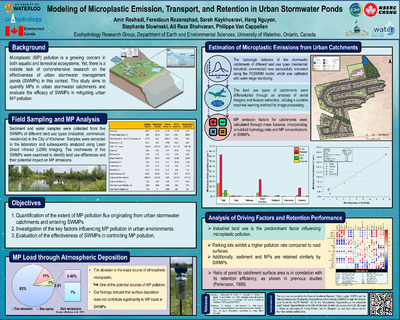| dc.contributor.author | Reshadi, Mir Amir Mohammad | |
| dc.contributor.author | Rezanezhad, Fereidoun | |
| dc.contributor.author | Kaykhosravi, Sarah | |
| dc.contributor.author | Nguyen, Thu Hang | |
| dc.contributor.author | Slowinski, Stephanie | |
| dc.contributor.author | Shahvaran, Ali Reza | |
| dc.contributor.author | Van Cappellen, Philippe | |
| dc.date.accessioned | 2024-02-23 14:19:07 (GMT) | |
| dc.date.available | 2024-02-23 14:19:07 (GMT) | |
| dc.date.issued | 2024 | |
| dc.identifier.uri | http://hdl.handle.net/10012/20363 | |
| dc.description.abstract | Urban areas are the major sources of microplastics to the environment, given their high concentration of people, road traffic, and mismanaged waste. Stormwater runoff, one of the major carriers of urban-derived MPs to downstream environments, is often treated by stormwater management systems, including stormwater ponds (SWPs). SWPs are known to accumulate MPs in their sediments; however, their effectiveness in reducing urban MP loads and the magnitude of urban MP emissions remain understudied. We established MP particle balances for 5 SWPs draining catchments with different land uses in Kitchener, Ontario, Canada to quantify catchment MP emission factors and SWP MP retention efficiencies using measurements of MP sediment accumulation rates and water column concentrations combined with catchment hydrological modeling. MPs were separated from the sediment and water samples using a density-based separation method and then analyzed by laser direct infrared spectroscopy for particle counts, size distributions and polymer compositions. The results show that fragment-shaped MP particles preferentially accumulate in sediments whereas fibers are relatively higher in the water columns and therefore not as well retained by SWPs. Polyamide and polyethylene were the dominant polymer types in the SWP sediments, despite their relatively low densities, suggesting an important role of mechanisms other than just density-based settling for the accumulation of MPs in SWPs. Total MP retention efficiencies ranged from 24 to 87% across the 5 SWPs. The calculated MP emission factors were negatively correlated with catchment road coverage yet positively correlated with mixed imperviousness, suggesting that while road traffic may produce MPs, they are not accumulators of MPs for wash off within the catchment, and the produced MPs are instead likely emitted outside of the catchment boundaries via atmospheric deposition. Overall, these results provide insight into the processes responsible for MP emissions in catchments as well as for MP accumulation in SWPs and into the roles of urban catchments as emitters of MPs and SWPs as accumulators of MPs in urban environments. | en |
| dc.description.sponsorship | This work was supported by the Canada Excellence Research Chair program (CERC) and the Natural Sciences and Engineering Research Council of Canada (NSERC) through the Alliance grant (Grant No: ALLRP 558435 – 20) for the "Microplastics Fingerprinting at the Watershed Scale" project. | en |
| dc.language.iso | en | en |
| dc.publisher | University of Waterloo | en |
| dc.subject | microplastic | en |
| dc.subject | urban stormwater | en |
| dc.subject | stormwater management ponds | en |
| dc.title | Modeling of Microplastic Emission, Transport, and Retention in Urban Stormwater Ponds | en |
| dc.type | Conference Poster | en |
| dcterms.bibliographicCitation | Reshadi, A., Rezanezhad, F., Kaykhosravi, S., Nguyen, H., Slowinski, S., Shahvaran, A.R., & Van Cappellen, P. (2024). Modeling of microplasic emission, transport, and retention in urban stormwater ponds. University of Waterloo. | en |
| uws.contributor.affiliation1 | Faculty of Science | en |
| uws.contributor.affiliation2 | Earth and Environmental Sciences | en |
| uws.typeOfResource | Text | en |
| uws.peerReviewStatus | Unreviewed | en |
| uws.scholarLevel | Graduate | en |

